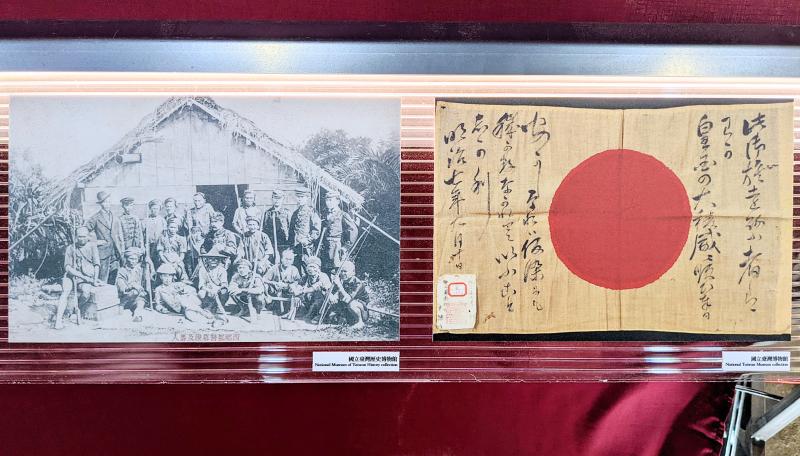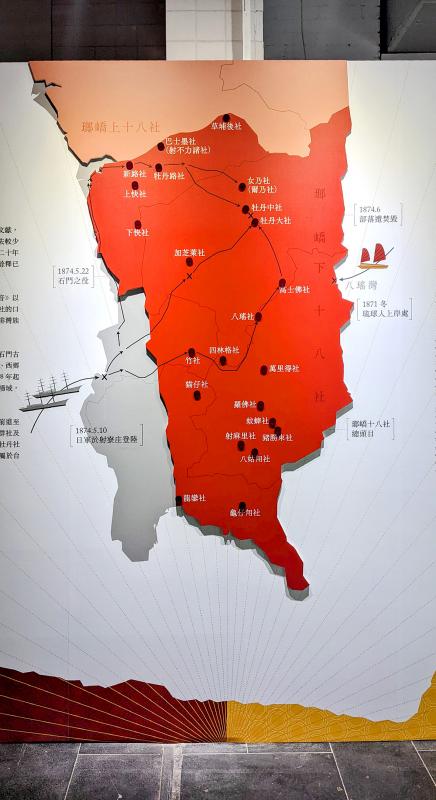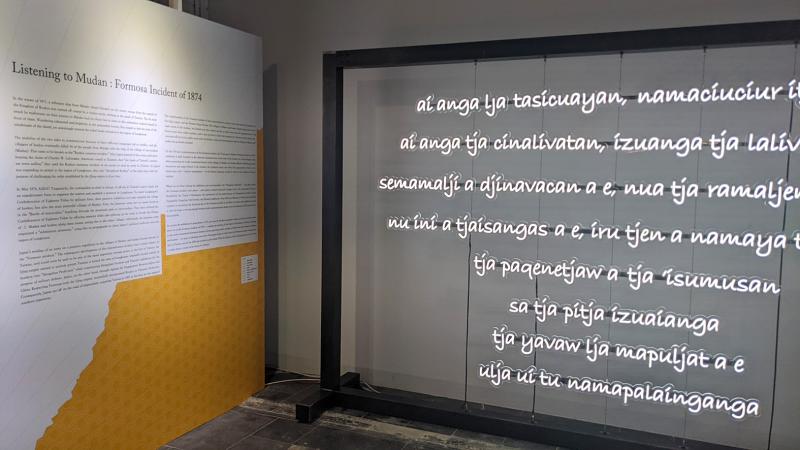A recording of Paiwan singers from Sinevaudjan Village echoes through the exhibition room, the lyrics looking back at the hardships their ancestors suffered to give them the life they have today. Nearly 150 years ago, the village was wiped off the map by the Japanese during the Mudan Incident (牡丹社事件), and it took 36 years for the people to return and rebuild it.
Due to a misunderstanding caused by language and cultural barriers, the ancestors of these singers — along with those from neighboring Kukus — killed 54 shipwrecked Ryukyuan sailors who had accidentally wandered into their territory in 1871. Their actions triggered a Japanese punitive expedition three years later that alarmed the Qing Dynasty, who long-treated Taiwan as a remote backwater that wasn’t worth investing in.
It was a pivotal moment in East Asian history. The Qing started paying more attention to governing and defending Taiwan, while Japan annexed the Kingdom of Ryukyu, its first move in what would be decades of imperial expansion.

Photo: Han Cheung, Taipei Times
Both Paiwan villages were burnt down, and for more than a century, the events were told exclusively from Japanese, Chinese and Western perspectives. Over the past 20 years, experts and locals have been reconstructing a new historical interpretation with the Paiwan as the main subjects. Earlier this month, Mudan Township unveiled new statues of Paiwan leader Aruqu Kavulungan and his son, who were killed in the incident but left out of the conventional narrative.
This display in Huashan 1914 Creative Park is a teaser for later next month’s Listening to Mudan: Formosa Incident of 1874 (聆聽牡丹的聲音) audiovisual exhibition that literally returns the voice to the Paiwan on their traditional land in Pingtung County. The Huashan exhibition closes on June 8, and the Pingtung event opens on June 24.
The Mudan Incident is often connected to the Rover Incident of 1867, which happened further to the south and was also triggered by Paiwan warriors killing shipwrecked foreigners — in this case Americans.

Photo: Han Cheung, Taipei Times
This story was recently dramatized into last year’s hit mini-series Seqalu, drawing much public interest to the history of this area. The research that led to this exhibition is the result of the International Conference on Encounters between Southern Formosa and World, which was held in November 2019, and two years of field research into both incidents by Story Studio (故事).
The Taipei display offers an atmospheric general overview of the events in Chinese and English, but in Pingtung visitors can listen to recordings of Kukus and Sinevaudjan descendants telling their accounts of the incident, which have been passed on orally through the generations, in the Paiwan language and tradition. This is symbolic because the original dispute was caused by cultural and linguistic differences, and most visitors will have to rely on the translations to understand it.
The Pingtung show will also provide transportation and possible tours to several historic sites related to the incident, including one of the main battlefields that can be explored through riverside trails restored earlier this year. Also on the list are the graves of the 54 Ryukuan victims and a memorial to the incident erected by the Japanese in 1935. The Chinese Nationalist Party (KMT) scratched off the memorial’s text after World War II, and it was only restored in 2020.

Photo: Han Cheung, Taipei Times
More details will be announced later next month.

Taiwan can often feel woefully behind on global trends, from fashion to food, and influences can sometimes feel like the last on the metaphorical bandwagon. In the West, suddenly every burger is being smashed and honey has become “hot” and we’re all drinking orange wine. But it took a good while for a smash burger in Taipei to come across my radar. For the uninitiated, a smash burger is, well, a normal burger patty but smashed flat. Originally, I didn’t understand. Surely the best part of a burger is the thick patty with all the juiciness of the beef, the

This year’s Miss Universe in Thailand has been marred by ugly drama, with allegations of an insult to a beauty queen’s intellect, a walkout by pageant contestants and a tearful tantrum by the host. More than 120 women from across the world have gathered in Thailand, vying to be crowned Miss Universe in a contest considered one of the “big four” of global beauty pageants. But the runup has been dominated by the off-stage antics of the coiffed contestants and their Thai hosts, escalating into a feminist firestorm drawing the attention of Mexico’s president. On Tuesday, Mexican delegate Fatima Bosch staged a

The ultimate goal of the Chinese Communist Party (CCP) is the total and overwhelming domination of everything within the sphere of what it considers China and deems as theirs. All decision-making by the CCP must be understood through that lens. Any decision made is to entrench — or ideally expand that power. They are fiercely hostile to anything that weakens or compromises their control of “China.” By design, they will stop at nothing to ensure that there is no distinction between the CCP and the Chinese nation, people, culture, civilization, religion, economy, property, military or government — they are all subsidiary

Would you eat lab-grown chocolate? I requested a sample from California Cultured, a Sacramento-based company. Its chocolate, not yet commercially available, is made with techniques that have previously been used to synthesize other bioactive products like certain plant-derived pharmaceuticals for commercial sale. A few days later, it arrives. The morsel, barely bigger than a coffee bean, is supposed to be the flavor equivalent of a 70 percent to 80 percent dark chocolate. I tear open its sealed packet and a chocolatey aroma escapes — so far, so good. I pop it in my mouth. Slightly waxy and distinctly bitter, it boasts those bright,